|


Easter Island
A Stone-Age Civilization of the Pacific
|
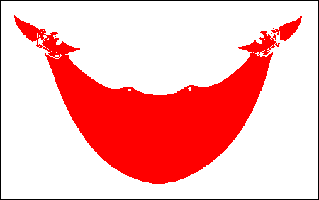
Native Flag of
Easter Island - Reimiro |
Easter Island
is the world's most isolated inhabited island. It is also one of
the most mysterious. Easter Island is roughly midway between
Chile and Tahiti.
The triangular
shaped island is made mostly of volcanic rock. Small coral
formations exist along the shoreline, but the lack of a coral
reef has allowed the sea to cut cliffs around much of the
island. The coastline has many lava tubes and volcanic caves.
The only sandy beaches are on the northeast coast.
|

Map
|
|

Ovahe Beach, North
Shore |
The inhabitants of this
charming and mysterious place called their land: TePito
o TeHenua, 'the navel of the world.'
It sits in the South Pacific Ocean 2,300 miles west of South America,
2,500 miles southeast of Tahiti, 4,300 miles south of Hawaii, 3,700
miles north of Antarctica.
The closest other
inhabited island is 1,260 miles away - tiny Pitcairn Island
where the mutineers of the H.M.S. Bounty settled in 1790.
|
 |
Archaeological evidence
indicates discovery of the island by Polynesians at about 400 AD.
In 1722, a Dutch explorer, Jacob Roggeveen, sighted and visited
the island.
This happened to be on a
Sunday, Easter Sunday to be precise, and the name
stuck:
Easter Island (Isla de Pascua in Spanish).
What he discovered on
Easter Island were three distinct groups of people,
The Polynesian name of the
island is Rapanui, which is a name given by a Tahitian
visitor in the 19th century who says that the island looked like the
Tahitian island of 'Rapa,' but bigger, 'Nui.'
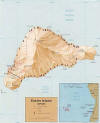 Inhabitants are of Polynesian
descent, but for decades anthropologists have argued the true origins of
these people, some claiming that ancient South-American mariners settled the
island first. Inhabitants are of Polynesian
descent, but for decades anthropologists have argued the true origins of
these people, some claiming that ancient South-American mariners settled the
island first.
What many early
explorers who visited the island found, was a scattered
population with almost no culture they could remember and
without any links to the outside world.
The Easter islanders were easy prey for 19th century slave
traders which depreciated even more their precarious culture,
knowledge of the past, and skills of the ancestors.
THE MOAI
When we think of Eastern Island we think of of huge stone carved figures
-monoliths- that dot the coastline.
They are called Moai and are carved from island rock.
The Moai are seen all over the island, and in different
shapes, sizes, and stages of completion. Many Moaiare left unfinished at the
quarry site. No one is sure yet as to what purposes did the Moai
served, but outside scholarly research together with accumulated local
knowledge, shows evidence that the Moai were carved by the
ancestors of the present inhabitants.
Ron Fisher in his work Easter Island Brooding Sentinels of
Stone, mentions as one explanation for the statues that "two classes
of people, the-so-called Long Ears and Short Ears,
lived on the island. The Short Ears were enslaved by the Long Ears, who
forced the Short Ears to carve the Moai. After many
generations and during a rebellion, the Short Ears surprised
the Long Ears killing them all, which explains the abrupt end
of the statue-carving.
|

Some of the
Moai face the sea
|

Most face inland to
watch over the villages |

Many of the were
buried up to their shoulders and thereby appearing as
disembodied heads |
All of the Moai
were toppled in tribal wars about 250 years ago. Many have recently been
rebuilt - starting in the 1950's. They sit on rocky lava strewn about
telling a story of fallen monuments of a long lost civilization who created
them. The Moai were depictions of their ancestors. The
Rapa Nui were ancestor worshipers and only had one diety -
Make Make. The Moai were excavated for the first time
by Thor Heyerdahl in the 1950's and were photographed at that time.
AHU
Ahu Akivi
is an especially sacred place. Ahu Akivi is a
sanctuary and celestial observatory built about 1500 AD which
|
 |
 |
|
Moai sit on
platforms - ceremonial shrines called Ahu |
was the subject of the first serious restoration accomplished on
Easter Island by archaeologists William Mulloy
and Gonzalo Figueroa, with excellent results.
As in the case of many religious
structures on Easter Island, it has been situated with astronomical
precision: it's seven statues look towards the point where the sun sets
during the equinox. It is also aligned to the moon.
Ahu Akivi is an unusual site in several respects. A low
ahu supports 7 statues all very similar in height and style. The
site is odd in that it is located far inland and the statues were erected to
face the ocean. The only site where this was done. Like other Easter
Island sites the statues were found knocked off the ahu,
lying face down in the ground. In 1960, Archeologist William Mulloy's
team spent several months raising the statues to their original positions.
During the excavation and restoration of this site many cremation pits were
uncovered behind the ahu. The pits contained fragments of
bone, shells, fishing implements, and obsidian flakes. Whether sites like
these were used regularly for cremations and or burials is not certain. At
other sites skeletons have been found buried within the ahu structure, but
these burials are believed to have occurred after the statues were toppled.
Folklore holds that its seven moai represent the seven
young explorers that legend says the Polynesian King Hotu Matu'a
dispatched from across the seas, probably from the Marquesas Islands, to
find this new homeland for him and his people. They are among the few
moai that face the sea.
These seven stone giants may well symbolize those seven explorers, but no
one knows for sure. Just as no one knows what any of the moai
really represent or why only a few of them face the sea.
The generally accepted theory is that these majestic stone statues were
built to honor Polynesian gods and deified ancestors such as chiefs and
other figures important in the island's history. Most of them are attributed
to the 14th and 15th centuries, although some were erected as long ago as
the 10th Century.
Their function, it is believed, was to look out over a village or gravesite
as a protector. They may also have been status symbols for villages or
clans.
The seven at Ahu Akivi each stand about 16 feet high and weigh
about 18 tons. The tallest moai on the island exceed 30 feet.
Moai
in the range of 12 to 20 feet are common. Even the occasional
tiny moai that you come across are at least 6 feet high.
The ahu of Easter Island vary in length - the longest one is
300 feet, while some that hold one moai are only several feet
long. Each
ahu has a stone masonry base that slopes upward to a high terrace
upon which the moai rest. Some terraces are as high as 15 feet
above ground level. All are fairly wide - the bases of the moai
that stand upon them measure as much as 10 feet long by 8 or 9 feet wide.
The island's volcanic rock from which they were carved is softer and lighter
than most other rock, but even the smallest moai weighs several tons.
Some of the moai have been estimated to weigh as much as 80 to
90 tons. Many of the moai - there are hundreds of them - are
erected at sites miles from the quarry at which they were carved. How could
so few people move them even a couple of feet, let alone several miles, and
without breaking them?
And once they did move them, how did they erect them? Even today, using
powerful cranes, it would be no simple task.
Theories on how the Moai were moved
Many Rapa Nui people believe that the statues were moved and
erected by
'mana'
a magical force. Great kings of a long-gone era simply used
their
mana to command the moai to move to the distant
sites and stand there.
Mana is a word and concept you hear frequently in South Seas
lore. The people of
Rapa Nui believed that the moai also possessed
mana, which was instilled at the time their white coral eyes were
put in place, and that the moai used their
mana to protect the people of the island. Today none of the
moai have genuine coral eyes - and thus the mana is
no more.
The intervention of Extraterrestrials - the most infamous of these writers
is Erich Von Daniken who suggests that a small group of 'intelligent
beings' were stranded there and taught the natives to make 'robot-like'
statues. His main thrust is that the stone from which the statues are made
is not found on the island - a complete fabrication. This links with
theories that Easter Island was once part of the lost
civilization of flying machines.
Other theories include, men sliding the moai along on layers
of yams and sweet potatoes.
The generally accepted belief is that they were transported on sledges or
log rollers and then levered erect using piles of stones and long logs.
Thor Heyerdahl, whose books Kon-Tiki and Aku-Aku stirred great
interest in
Easter Island, conducted an experiment showing that an upright
stone statue could be moved using ropes, tilting and swiveling it along. But
the experiment was conducted on a flat surface for only a short distance,
and this theory, like Heyerdahl's theory that the islands of the South
Pacific were settled from east to west from South America rather than from
west to east from Southeast Asia, is not considered plausible.
All but a few of the moai of Easter Island were carved at
Rano Raraku, a volcanic cone that contains a crater lake. It is
an eerie spot. Scattered all around Rano Raraku are 394
moai in every stage of evolution. Some are fallen - a common sight
around the island - and some appear to have only heads, although they are
really full figures that have been nearly buried by soil over the centuries.
For reasons that remain a mystery, it appears that the workers at Rano
Raraku set down their tools in the middle of a multitude of projects
- and the moai-building abruptly ceased.
RONGORONGO
Rongo-rongo is the hieroglyphic script of Easter Island. It
has remained a mystery since its discovery. For over a hundred years,
controversy has raged over the meaning and source of these enigmatic
characters.

There are only 21 known tablets in existence - scattered in museums and
private collections. Tiny, remarkably regular glyphs, about one centimeter
high, highly stylized and formalized, are carved in shallow grooves running
the length of the tablets.
Oral tradition has it that scribes used obsidian
flakes or shark teeth to cut the glyphs and that writing was brought by the
first colonists led by Hotu Matua. Last but not least, of the twenty
one surviving tablets three bear the same text in slightly different
"spellings", a fact discovered by three schoolboys of St Petersburg (then
Leningrad), just before World War II.
|
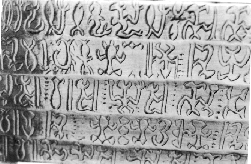
Rongo-rongo Tablet |
In 1868 newly converted Easter Islanders send to Tepano Jaussen,
Bishop of Tahiti, as a token of respect, a long twine of human hair, wound
around an ancient piece of wood. Tepano Jaussen examines the gift,
and, lifting the twine, discovers that the small board is covered in
hieroglyphs.
The bishop, elated at the discovery, writes to Father Hippolyte Roussel
on
Easter Island, exhorting him to gather all the
tablets he can and to seek out natives able to translate them. But only a
handful remain of the hundreds of tablets mentioned by Brother Eyraud
only a few years earlier in a report to the Father Superior of the
Congregation of the Sacred Heart.
Some say they were burnt to please the missionaries who saw in them evil
relics of pagan times. Some say they were hidden to save them from
destruction. Which side should we believe? Brother Eyraud had died in
1868 without having ever mentioned the tablets to anyone else, not even to
his friend Father Zumbohm, who is astounded at the bishop's
discovery. Monsignor Jaussen soon locates in Tahiti a laborer from
Easter Island,
Metoro, who claims to be able to read the tablets. He describes in
his notes how Metoro
turns each tablet around and around to find its beginning, then starts
chanting its contents.
The direction of writing is unique. Starting from the lefthand bottom
corner, you proceed from left to right and, at the end of the line, you turn
the tablet around before you start reading the next line. Indeed, the
orientation of the hieroglyphs is reversed every other line. Imagine a book
in which every other line is printed backtofront and upsidedown. That is
how the tablets are written! Jaussen was not able to decipher the
tablets.

There are also many zoomorphic figures, birds especially, fish and lizards
less often. The most frequent figure looks very much like the frigate bird,
which happens to have been the object of a cult, as it was associated with
MakeMake, the supreme god.
When you compare the tablets which bear the same text, when you analyze
repeated groups of signs, you realize that writing must have followed rules.
The scribe could choose to link a sign to the next, but not in any old way.
You could either carve a mannikin standing, arms dangling, followed
by some other sign, or the same mannikin holding that sign with one
hand. You could either carve a simple sign (a leg, a crescent) separate from
the next, or rotate it 90 degrees counterclockwise and carve the next sign
on top of it.
All we can reasonably hope to decipher some day is some two to
three lines of the tablet commonly called Mamari. You can
clearly see that they have to do with the moon. There are several versions
of the ancient lunar calendar of Easter Island.
PETROGLYPHS
On Easter Island, petroglyphs are located in every sector of
the island where there are suitable surfaces. Favored locations
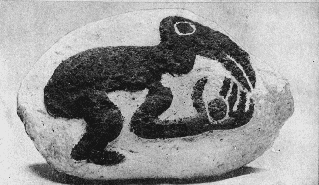 are smooth
areas of lava flow (called "papa" in Rapanui), or on smooth
basalt boulders. Most of these surfaces occur along coastal areas and often
are associated with major ceremonial centers. are smooth
areas of lava flow (called "papa" in Rapanui), or on smooth
basalt boulders. Most of these surfaces occur along coastal areas and often
are associated with major ceremonial centers.
Some important ahu
have, as part of their structure, elegantly carved basalt stones (pa'enga),
with petroglyphs on them. Paintings survive in caves or in some of the stone
houses at Orongo where they are protected against the
weathering process.
Thousands of petroglyphs - rock carvings - can be found on Easter Island.
Many represent animals, notably birds or anthropomorphic birdmen.
One of the most famous motifs on Easter Island is that of
birdman - a half-man, half bird image that was connected to cult
events at the sacred site of Orongo. A bit of background on
the culture is necessary to explain this unusual cult.
After the demise of the statue building, in the last days before the
invasion by Peruvian slave traders, there arose a cult
of the Birdman (Tangata Manu). The birdman was seen as
the representative on earth of the
creator god Makemake, and eventually, this cult surpassed the
traditional power of the king ariki.
Once a year, representatives from each clan would gather at the ceremonial
village of Orongo and swim to Motu Nui, a nearby
Islet to search for the egg of the Sooty Tern. On his return,
the competitor presented the egg to his representative who was then invested
with the title of Tangata Manu.
|
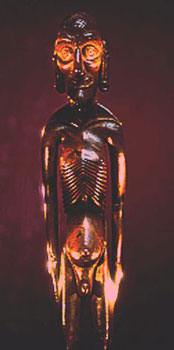
Moai Kavakava |
He then went down to Mataveri and from there was
led in procession to the southwest exterior slope of Rano Raraku,
where he remained in seclusion for a year. The Birdman ritual
was still in existence when Europeans arrived on Easter Island - therefore
historically documented. It was also featured quite prominently in
Kevin Costner's film "Rapa Nui".
In Hanga Roa, a sprawling and pleasant community where the
island's 2,775 residents live because it's the only area on the island with
electricity and running water. The most interesting souvenirs are miniature
wood and stone carvings of moais, though some stone samples up
to 6 feet tall are available.
A bearded emaciated man whose ribs and vertebrae are grotesquely extended.
It is said to represent the spirits of dead ancestors.
According to the local tradition, as Chief Tuu-ko-ihu was returning
home, he saw two such spirits who had protruding ribs and hollow bellies.
These
Aku Aku later appeared to him in a dream.
Other Rapa Nui wood carvings include: statues of female
figures (moai pa'a pa'a), paddles (rapa), clubs (ua), staffs ('ao), lizards
and birdman images (tangata manu).
Today, most of the original wood sculptures reside in museums around the
world - estranged from their ancestral home. The islanders still carve these
statues; continuing a tradition which, to this day, commands respect and
admiration from visitors.
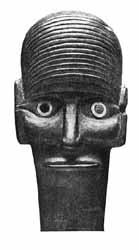
M.H. de Young Memorial Museum
TATOO
|
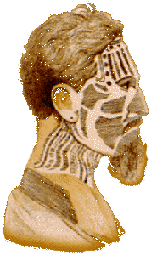 |
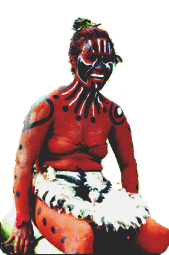 |
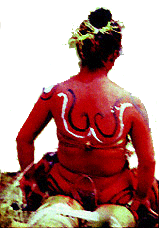 |
|
Wearing a tatoo in various parts of the body is a popular
custom |
CANNIBALISM
Every Easter Islander knows that his ancestors were kai-tangata,
'man-eaters'. Some make jokes about it, others take offense at any allusion
to this custom which has become in their eyes barbarous and shameful.
According to Father Roussel, cannibalism did not disappear until
after the introduction of Christianity. Shortly before this, the natives are
said to have eaten a number of men, including two Peruvian traders. Cannibal
feasts were held in secluded
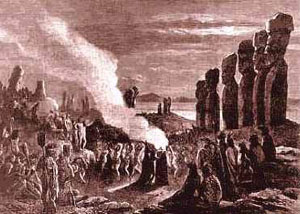 spots, and women and children were rarely
admitted. The natives told Father Zumbohm that the fingers and toes
were the choicest morsels. spots, and women and children were rarely
admitted. The natives told Father Zumbohm that the fingers and toes
were the choicest morsels.
The captives destined to be eaten were shut up in huts in front of the
sanctuaries. There they were kept until the moment when they were sacrificed
to the gods.
The Easter Islanders' cannibalism was not exclusively a religious rite or
the expression of an urge for revenge: it was also induced by a simple
liking for human flesh that could impel a man to kill for no other reason
than his desire for fresh meat. (Man was the only large mammal whose flesh
was available).
Women and children were the principal victims of these inveterate cannibals.
The reprisals that followed such crimes were all the more violent because an
act of cannibalism committed against the member of a family was a terrible
insult to the whole family. As among the ancient Maoris, those
who had taken part in the meal were entitled to show their teeth to the
relatives of the victim and say, 'Your flesh has stuck between my teeth'.
Such remarks were capable of rousing those to whom they were addressed to a
murderous rage not very different from the Maly amok.
|